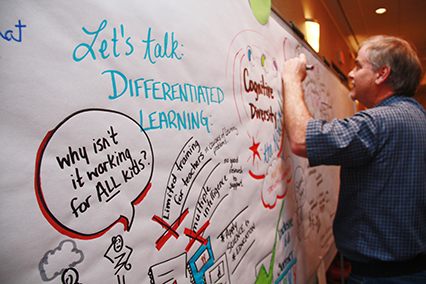Page Content
Brad Hale delivers his keynote address.
How do we create an approach to education in which inclusion is the design principle for all policy and practice?
That was the overarching question considered by the more than 200 participants who attended Reaching the Vision: Building Inclusive Education Together, the invitational symposium of the Blue Ribbon Panel on Inclusive Education in Alberta Schools.
Held April 24 in Edmonton, the symposium focused on recommendations one, five and six of the blue ribbon panel’s report, which was released last fall. The recommendations call on Alberta Education, school jurisdictions and schools to establish inclusive education advisory committees to develop respective provincial, jurisdiction and school implementation plans; guide implementation activities; and reflect on evidence gathered about implementation.
Keynote speaker Brad Hale proposed a multitiered model of service delivery designed to optimize academic and behavioural outcomes for all learners.

The Association sponsored an inclusion symposium that took place April 24 in Edmonton.
“Inclusive education is about understanding not only the child but [also] the environment that impacts them on a daily basis,” he said. “The primary therapists in kids’ lives are … parents and teachers.”
Hale is a pediatric neuropsychologist; school psychologist and special education teacher; and professor of education, pediatrics and psychiatry at the University of Calgary. He pointed out that, while professionals do not understand what causes learning problems, cognitive diversity is the norm, not the exception, with 80 to 85 per cent of the population having at least one significant cognitive strength or weakness.
“That’s why inclusive education has to happen,” he said. “Training and support of teachers in serving diverse needs is essential practice … Teachers need to be empowered to be successful in the classroom.”
Hale told participants that some of the most effective teaching strategies are regular communication with students, direct instruction, remediation, classroom structure and homework.
“Kids’ brains learn by practice. They not only need to learn a skill, [but] they need to practice it over and over again,” he said. “The brain has to make lower-level skills automatic, and to make those skills automatic, [children] have to practise them … If you look at high-quality education across the world, the highest educational achievement occurs in schools where practise and repetition of skills to the level of automaticity is a key component.”
In contrast, individualization has so far proven to be less effective.
“When you think about individualized instruction, it’s not the pullout or segregated settings. Individualization can happen in inclusive settings. What it requires is what expert teachers do naturally, or are trained to do, and that is to adapt instruction on the fly,” he said. “I think individualization can happen, but we haven’t done it well in the past.”
Hale suggested that, while children with learning disabilities have biological, brain-based differences that cause the disabilities, they also have processing deficits.
“Poor instruction can cause processing deficits,” he added.
He panned ability achievement discrepancy as a method of identifying learning disabilities. In schools that conduct ability achievement discrepancy, the children who are tutored or who receive help from their parents tend not to receive services “because they’re not discrepant enough.”
While sociocultural, ethnic, racial, linguistic and cognitive differences can result in the overidentification of children with diverse backgrounds, intelligence tests are just another kind of achievement test, with children from affluent backgrounds doing better on such tests than children with impoverished backgrounds, he said.
He also pointed out that some schools do not allow children to be referred for evaluation until Grade 3, when they face a two-year waiting list.
“By the time the child actually gets evaluation and services provided, their brain has automatically prescribed dysfunction for that child,” he said.
Hale emphasized the need to meet children’s needs as early as possible, even at the preschool level.
“If the government wants to spend a lot of money in a particular area, it would be preschool education,” he said to applause. “We don’t pay enough attention to kids when they’re really young, when their brains are developing the most.”
He suggested that the response to intervention (RTI) approach should be mandated in Alberta. While it does not diagnose learning disabilities or other disorders, it can prevent them and it does work to improve education for all children, he said.
Hale then proposed a multitiered model of service delivery to foster a truly inclusive education system. The first tier — differentiated instruction — would meet the needs of 85 per cent of children. The second tier — small-group instruction — would meet the needs of another 10 per cent. And the third tier — individualized instruction — would meet the needs of the remaining five per cent.
“Disabilities don’t need to be lifelong [because] the brain changes much more quickly than we ever anticipated,” he concluded. “That is what teachers’ job is — teaching is changing brain function.” ❚
Following Hale’s keynote presentation, blue ribbon panel chair Marc Arnal briefed participants on the panel's deliberations. University of Alberta researcher Jason Daniels then highlighted some of the research findings that informed those deliberations. After lunch, a group of academics described their research on inclusion. The group included Rauno Parrila, an educational psychology professor at the University of Alberta; Kathy Howery, a U of A PhD candidate; and Hale.
Throughout the day, participants engaged in table discussions using the objective/reflective/interpretative/decisional conversation method, ending with a call to action.
